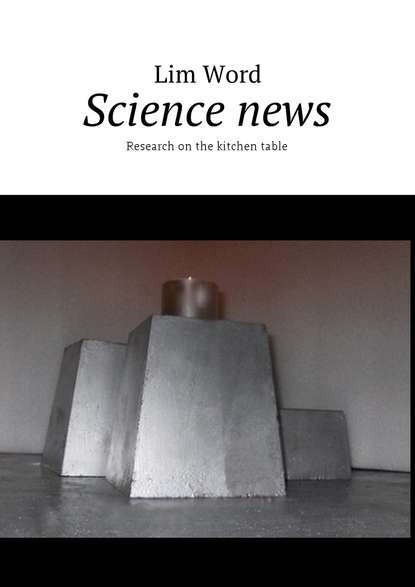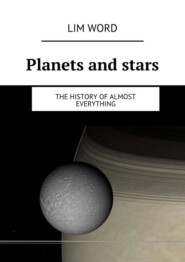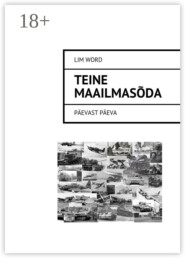По всем вопросам обращайтесь на: info@litportal.ru
(©) 2003-2024.
✖
Science news. Research on the kitchen table
Настройки чтения
Размер шрифта
Высота строк
Поля
Science news. Research on the kitchen table
Lim Word
Everything new is being sought not in huge institutions, but in our home laboratory. Almost from scratch. You will learn how to concentrate the energy scattered in nature, restore the past, and see the invisible.
Science news
Research on the kitchen table
Lim Word
© Lim Word, 2018
ISBN 978-5-4485-6692-9
Created with Ridero smart publishing system
…How to collect scattered in space, as if already asleep energy? Obviously, there are natural natural processes that increase its quality to its original value.
These are not some complicated devices. Everything happens by itself. You just need to be able to see.
The hot kettle on the table gives energy to the space – the table, the streams of air, etc. With the passage of time it cools down. The motion of molecules is evenly distributed in the environment. The energy of high order disappeared, replaced by a uniform thermal background. Is it possible to reverse the process? Will the impulses from the environment of the teapot be transferred in a particular case, will it boil right on your kitchen table?
This is how it should be if in nature, from the beginning of time, there is a cycle of energy.
One of the author’s first publications on this topic is an article in “TM”, No. 4, 2000:
“What is the difference between an object of the macrocosm – a monolith – from a cloud of dust obtained as a result of its long grinding and subsequent shaking? Well-known: the area of contact with the environment of another phase, for example, with gas. That is why the chemical reactions that occur in powders are completely unaffected by monoliths, iron filings burn in the air, whereas an iron nail, except in pure oxygen…
Dusty laser?
But the question is: what happens when the monolith is grinded or, conversely, how does the dust coalesce again into a monolith with a radiation-absorption spectrum? Let’s help the laws of quantum physics.
In monolith, the spectrum runs through all the energy levels, theoretically, as many as the atoms in the body. In a gas, individual atoms radiate independently, on a few levels. But when the neighboring atoms appear, the levels shift so as not to repeat each other, the prohibition principle introduced at the beginning of the 20th century works. Wolfgang Pauli: there can not be interconnected atoms, the energy parameters of which are completely the same.
But the powder is an intermediate state between the gas and the solid. Apparently, a sharp boundary, on which the properties change spasmodically, can not be carried out. And accordingly, the spectrum of the dust cloud, as the particles are fragmented, will approach the gas spectrum.
But what happens if you thicken it to the volume of the original monolith?
When merging, say, a hundred particles, each energy level will take at once one hundred atoms. To restore the order adopted in the microcosm, each of these supersaturated levels will tend to split into a hundred isolated spectral lines. The most natural way to restore the energy hierarchy for atoms of a newly formed monolith is to radiate a certain number of electromagnetic quanta. Consequently, the condensed cloud of dust will become generally colder than the surrounding environment.
Are we humans the same hubs? Than our cells are not isolated “motes” separated by membranes? But the permeability of membranes is constantly changing. And are there many unrelated properties of living organisms that are not associated with such a unification of many millions of “dust particles”?”
Continuation – in the article “Energy concentrators”, “TM” No. 6, 2002, already based on practical, not mental experiments.
1. cabinet with thermal insulation
2. Dewar vessels
3. continuous medium (water)
4. porous medium
5. electronic thermometers (error not more than 0,02С)
6. temperature sensors
Two vessels – one with a porous medium, the other – with a solid, are located in a thermally insulated cabinet. They have thermal sensors; the temperature inside is measured every 20 minutes.
It was found out that the temperature in a container with a granulated medium (wet sand, etc.) varies abruptly, with considerable amplitude. The solid medium gives a very flat temperature graph, without bursts and any periodicity.
Porous, granular, otherwise – ordered matter has the property of ordering – to collect in space and time, energy. Probably, this property manifests itself on different scales. Local heating can also occur in a handful of sand, earth, porous clay, only one or two degrees, and in large areas, in square kilometers. The temperature can increase by tens, hundreds of degrees, possibly accompanied by radioactive emissions. So the energy of a high level comes back to the world.
In a certain way ordering matter, it is possible to achieve a predictable ejection of heat (or cold), in certain areas of the created system. Covered by feedback, the system creates a “cold-heat” pulsation; from this one can obtain a steady stream of energy. The ordering can be performed on macroscopic (fractions of a millimeter) and micro-levels (the distance between the atoms of the crystal). In the latter case, it is possible to achieve not intermittent flicker, “eternal radiance”.
In the first approximation, the concentration system looks like the organization of flows of a homogeneous, initially disconnected substance to some common point, a kind of “heart” with subsequent separation.
Some successes in this, perhaps even intuitively realizing the essence of the process, were achieved by American researchers Fleischman and Pons. They are known to conduct electrolysis of heavy water on palladium electrodes. Their idea – the molecules of the hydrogen isotope accumulate in the crystal lattice of the metal, as closely as possible – and interact. As a result of the “cold nuclear fusion” (NNS), an anomalous heat release occurred (four times higher than the calculated one), but, in addition, there was no neutron radiation associated with it.
In the end, experiments – although they were reproduced in other laboratories, were abandoned, they were almost forgotten. But, with a satisfactory theory: “A structured substance structures energy, creates an order around itself,” they can be revived, put on an appropriate, correct pattern. Hydrogen atoms were collected in one small volume, and therefore they were forced to radiate (relatively soft) photons from their upper energy levels. Isotopes, the synthesis of light nuclei, radiation – this can be forgotten. New reactors of Eternal Motors are loaded with any, not radioactive, but – structured substance.
Note: A structured body (massif) is a cluster of clusters (dust grains) of a substance of equal shape, composition that is some distance from each other in a semitransparent medium or a vacuum. An additional structure in time, give periodic rendezvous and separation of particles – which is like breathing or pulse.
The author reproduced the experiments of Fleischmann and Pons at home, replacing heavy water with ordinary tap water, and palladium electrodes with sand.
It turned out this article:
Electrons get tired?
“Some of the fundamental laws of physics are so simple and obvious that no one doubts their justice, and no one is involved in their verification. In particular, this applies to Ohm’s law, according to which the direct current in the circuit (in any case at its low density) is equal to the voltage divided by the resistance: I = U / R. This is followed by other rules of electrical engineering. For example, according to the Joule-Lentz law, the heat W allocated to the resistance R is directly proportional to the voltage drop across it U, the current I and the duration of its passage t, that is, W = R-U-1-t. Therefore, if two identical resistances are sequentially included in a closed circuit, then the same amount of heat should be allocated to them in a unit of time. It seems quite obvious that, bypassing the first resistance, the electrons are not able to either acquire additional energy or lose it.
But does Ohm’s law really hold for resistances of all kinds at low current densities? Interested in this issue, I performed a series of simple experiments. Two, if possible, the same resistance, I included in the DC circuit, and next to them attached sensors sensitive thermometers. Each resistance, together with its “own” sensor, was placed in a separate thermostat.
In the first experiments, as resistance, I used incandescent lamps (calculated for a voltage of 2.5 V and a current of 0.15 A). Turning on the current (its source was a reducing stabilizing transformer and a rectifier included in a household circuit with a voltage of 220 V), I measured the temperature in thermostats for an hour; then changed the lamps in places and repeated the measurements. Five series of similar experiments showed that the metallic resistances gave off the amount of heat in full accordance with the classical laws of electrical engineering, and no matter where these resistances were located.
I did not make measurements using resistances of other types, but I performed the experiment using electrolytic cells as a resistance in which ordinary tap water was decomposed on stainless steel electrodes; the result again did not reveal any anomalies.
But if electrolysis of water was carried out in a porous, heterogeneous medium, the picture turned out to be different.
I filled the electrolytic cells with a mixture of quartz sand and tap water, acidified for better electrical conductivity by several drops of hydrochloric acid (which, generally speaking, is not necessary). And the first experiments gave amazing results, not corresponding to the classical laws of electrical engineering.
Namely, the temperature in the thermostat located in the course of the motion of the electrons turned out to be much higher than the temperature in the next thermostat! At a voltage of a current source of 220 V and its strength of 0.5 A, the difference was 90°C, which significantly exceeded the error value of previous experiments. In total I performed 10 similar experiments and noticed that the difference in temperature between cells clearly depends on the current strength in the circuit and can reach even a few tens of degrees.
I also noticed that on the first cell the voltage drop was higher than the second one (150 and 70 V, respectively), which explains the increased heat release. But the main question remained without an answer: why is there such a noticeable asymmetry, if before and after the experiments the resistance of the cells were the same? After all, this effect should not be!
It can be assumed that in the first cell the electrons for some reason lose some of their internal energy and therefore in the second cell they are no longer able to interact with ions as intensively. But in fact the second cell too (though not style strongly) heats up. True, in the sand-water electrolytic cells there are many local and rather sharp differences in the resistance of the medium, as a result of which the electrons in it are sharply accelerated, then they are sharply slowed down. Is not this the reason for the effect that I observed?
Of course, my assumption that after passing a certain device, the electrons can seem to get tired, giving the environment some special energy, contradicts the laws of nuclear physics, according to which the electron does not have an internal structure and has only a reserve of external kinetic energy. But if I’m wrong, then let me point out the error, preferably by repeating my experiments.
1—4. electrodes made of stainless steel
Lim Word
Everything new is being sought not in huge institutions, but in our home laboratory. Almost from scratch. You will learn how to concentrate the energy scattered in nature, restore the past, and see the invisible.
Science news
Research on the kitchen table
Lim Word
© Lim Word, 2018
ISBN 978-5-4485-6692-9
Created with Ridero smart publishing system
…How to collect scattered in space, as if already asleep energy? Obviously, there are natural natural processes that increase its quality to its original value.
These are not some complicated devices. Everything happens by itself. You just need to be able to see.
The hot kettle on the table gives energy to the space – the table, the streams of air, etc. With the passage of time it cools down. The motion of molecules is evenly distributed in the environment. The energy of high order disappeared, replaced by a uniform thermal background. Is it possible to reverse the process? Will the impulses from the environment of the teapot be transferred in a particular case, will it boil right on your kitchen table?
This is how it should be if in nature, from the beginning of time, there is a cycle of energy.
One of the author’s first publications on this topic is an article in “TM”, No. 4, 2000:
“What is the difference between an object of the macrocosm – a monolith – from a cloud of dust obtained as a result of its long grinding and subsequent shaking? Well-known: the area of contact with the environment of another phase, for example, with gas. That is why the chemical reactions that occur in powders are completely unaffected by monoliths, iron filings burn in the air, whereas an iron nail, except in pure oxygen…
Dusty laser?
But the question is: what happens when the monolith is grinded or, conversely, how does the dust coalesce again into a monolith with a radiation-absorption spectrum? Let’s help the laws of quantum physics.
In monolith, the spectrum runs through all the energy levels, theoretically, as many as the atoms in the body. In a gas, individual atoms radiate independently, on a few levels. But when the neighboring atoms appear, the levels shift so as not to repeat each other, the prohibition principle introduced at the beginning of the 20th century works. Wolfgang Pauli: there can not be interconnected atoms, the energy parameters of which are completely the same.
But the powder is an intermediate state between the gas and the solid. Apparently, a sharp boundary, on which the properties change spasmodically, can not be carried out. And accordingly, the spectrum of the dust cloud, as the particles are fragmented, will approach the gas spectrum.
But what happens if you thicken it to the volume of the original monolith?
When merging, say, a hundred particles, each energy level will take at once one hundred atoms. To restore the order adopted in the microcosm, each of these supersaturated levels will tend to split into a hundred isolated spectral lines. The most natural way to restore the energy hierarchy for atoms of a newly formed monolith is to radiate a certain number of electromagnetic quanta. Consequently, the condensed cloud of dust will become generally colder than the surrounding environment.
Are we humans the same hubs? Than our cells are not isolated “motes” separated by membranes? But the permeability of membranes is constantly changing. And are there many unrelated properties of living organisms that are not associated with such a unification of many millions of “dust particles”?”
Continuation – in the article “Energy concentrators”, “TM” No. 6, 2002, already based on practical, not mental experiments.
1. cabinet with thermal insulation
2. Dewar vessels
3. continuous medium (water)
4. porous medium
5. electronic thermometers (error not more than 0,02С)
6. temperature sensors
Two vessels – one with a porous medium, the other – with a solid, are located in a thermally insulated cabinet. They have thermal sensors; the temperature inside is measured every 20 minutes.
It was found out that the temperature in a container with a granulated medium (wet sand, etc.) varies abruptly, with considerable amplitude. The solid medium gives a very flat temperature graph, without bursts and any periodicity.
Porous, granular, otherwise – ordered matter has the property of ordering – to collect in space and time, energy. Probably, this property manifests itself on different scales. Local heating can also occur in a handful of sand, earth, porous clay, only one or two degrees, and in large areas, in square kilometers. The temperature can increase by tens, hundreds of degrees, possibly accompanied by radioactive emissions. So the energy of a high level comes back to the world.
In a certain way ordering matter, it is possible to achieve a predictable ejection of heat (or cold), in certain areas of the created system. Covered by feedback, the system creates a “cold-heat” pulsation; from this one can obtain a steady stream of energy. The ordering can be performed on macroscopic (fractions of a millimeter) and micro-levels (the distance between the atoms of the crystal). In the latter case, it is possible to achieve not intermittent flicker, “eternal radiance”.
In the first approximation, the concentration system looks like the organization of flows of a homogeneous, initially disconnected substance to some common point, a kind of “heart” with subsequent separation.
Some successes in this, perhaps even intuitively realizing the essence of the process, were achieved by American researchers Fleischman and Pons. They are known to conduct electrolysis of heavy water on palladium electrodes. Their idea – the molecules of the hydrogen isotope accumulate in the crystal lattice of the metal, as closely as possible – and interact. As a result of the “cold nuclear fusion” (NNS), an anomalous heat release occurred (four times higher than the calculated one), but, in addition, there was no neutron radiation associated with it.
In the end, experiments – although they were reproduced in other laboratories, were abandoned, they were almost forgotten. But, with a satisfactory theory: “A structured substance structures energy, creates an order around itself,” they can be revived, put on an appropriate, correct pattern. Hydrogen atoms were collected in one small volume, and therefore they were forced to radiate (relatively soft) photons from their upper energy levels. Isotopes, the synthesis of light nuclei, radiation – this can be forgotten. New reactors of Eternal Motors are loaded with any, not radioactive, but – structured substance.
Note: A structured body (massif) is a cluster of clusters (dust grains) of a substance of equal shape, composition that is some distance from each other in a semitransparent medium or a vacuum. An additional structure in time, give periodic rendezvous and separation of particles – which is like breathing or pulse.
The author reproduced the experiments of Fleischmann and Pons at home, replacing heavy water with ordinary tap water, and palladium electrodes with sand.
It turned out this article:
Electrons get tired?
“Some of the fundamental laws of physics are so simple and obvious that no one doubts their justice, and no one is involved in their verification. In particular, this applies to Ohm’s law, according to which the direct current in the circuit (in any case at its low density) is equal to the voltage divided by the resistance: I = U / R. This is followed by other rules of electrical engineering. For example, according to the Joule-Lentz law, the heat W allocated to the resistance R is directly proportional to the voltage drop across it U, the current I and the duration of its passage t, that is, W = R-U-1-t. Therefore, if two identical resistances are sequentially included in a closed circuit, then the same amount of heat should be allocated to them in a unit of time. It seems quite obvious that, bypassing the first resistance, the electrons are not able to either acquire additional energy or lose it.
But does Ohm’s law really hold for resistances of all kinds at low current densities? Interested in this issue, I performed a series of simple experiments. Two, if possible, the same resistance, I included in the DC circuit, and next to them attached sensors sensitive thermometers. Each resistance, together with its “own” sensor, was placed in a separate thermostat.
In the first experiments, as resistance, I used incandescent lamps (calculated for a voltage of 2.5 V and a current of 0.15 A). Turning on the current (its source was a reducing stabilizing transformer and a rectifier included in a household circuit with a voltage of 220 V), I measured the temperature in thermostats for an hour; then changed the lamps in places and repeated the measurements. Five series of similar experiments showed that the metallic resistances gave off the amount of heat in full accordance with the classical laws of electrical engineering, and no matter where these resistances were located.
I did not make measurements using resistances of other types, but I performed the experiment using electrolytic cells as a resistance in which ordinary tap water was decomposed on stainless steel electrodes; the result again did not reveal any anomalies.
But if electrolysis of water was carried out in a porous, heterogeneous medium, the picture turned out to be different.
I filled the electrolytic cells with a mixture of quartz sand and tap water, acidified for better electrical conductivity by several drops of hydrochloric acid (which, generally speaking, is not necessary). And the first experiments gave amazing results, not corresponding to the classical laws of electrical engineering.
Namely, the temperature in the thermostat located in the course of the motion of the electrons turned out to be much higher than the temperature in the next thermostat! At a voltage of a current source of 220 V and its strength of 0.5 A, the difference was 90°C, which significantly exceeded the error value of previous experiments. In total I performed 10 similar experiments and noticed that the difference in temperature between cells clearly depends on the current strength in the circuit and can reach even a few tens of degrees.
I also noticed that on the first cell the voltage drop was higher than the second one (150 and 70 V, respectively), which explains the increased heat release. But the main question remained without an answer: why is there such a noticeable asymmetry, if before and after the experiments the resistance of the cells were the same? After all, this effect should not be!
It can be assumed that in the first cell the electrons for some reason lose some of their internal energy and therefore in the second cell they are no longer able to interact with ions as intensively. But in fact the second cell too (though not style strongly) heats up. True, in the sand-water electrolytic cells there are many local and rather sharp differences in the resistance of the medium, as a result of which the electrons in it are sharply accelerated, then they are sharply slowed down. Is not this the reason for the effect that I observed?
Of course, my assumption that after passing a certain device, the electrons can seem to get tired, giving the environment some special energy, contradicts the laws of nuclear physics, according to which the electron does not have an internal structure and has only a reserve of external kinetic energy. But if I’m wrong, then let me point out the error, preferably by repeating my experiments.
1—4. electrodes made of stainless steel











